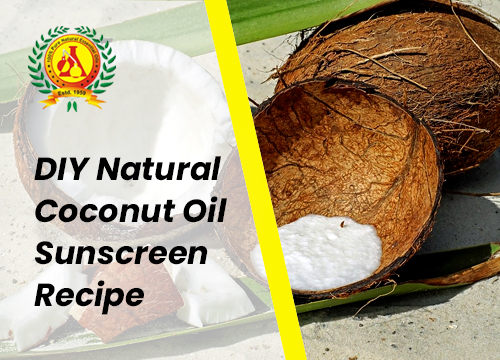Are you tired of commercial sunscreens filled with chemicals you can’t pronounce? Do you want a more natural, DIY alternative that not only protects your skin but nourishes it too? Look no further! This homemade coconut oil sunscreen recipe is easy to make, effective, and gentle on your skin. Plus, it’s eco-friendly and free of harmful ingredients. Let’s dive into the steps to create your own natural sunscreen.
Why Choose a Natural Sunscreen?
Before we get into the recipe, let’s talk about why natural sunscreens are a great option. Commercial sunscreens often contain synthetic chemicals like oxybenzone and octinoxate, which can irritate the skin and harm coral reefs. A natural sunscreen using coconut oil and other natural ingredients not only provides adequate sun protection but also nourishes your skin with vitamins and antioxidants.
Additionally, many people find that natural sunscreens are less likely to cause allergic reactions. They tend to be gentler on the skin, making them ideal for those with sensitive skin or conditions like eczema. By choosing a DIY natural sunscreen, you have complete control over the ingredients, ensuring that you’re using the safest, most beneficial components for your skin.
The Benefits of Coconut Oil
Coconut oil is a superstar in the world of natural skincare. It’s rich in medium-chain fatty acids, which have antibacterial and antifungal properties, helping to keep your skin healthy and clear. The natural SPF of coconut oil, while not very high, provides a base level of sun protection and can help to soothe and moisturize the skin.
Moreover, coconut oil is packed with antioxidants that help protect the skin from free radical damage caused by UV exposure. These antioxidants also promote the healing and repair of the skin, making coconut oil an excellent ingredient for a homemade sunscreen.
Ingredients You’ll Need
To create your DIY natural coconut oil sunscreen, you’ll need the following ingredients:
- 1/2 cup Coconut Oil: Known for its moisturizing properties and natural SPF of about 4-5.
- 1/4 cup Shea Butter: Provides additional moisturizing benefits and has a natural SPF of 4-6.
- 1/4 cup Beeswax: Helps the sunscreen stay solid and water-resistant.
- 2 tablespoons Zinc Oxide Powder: A natural mineral that provides broad-spectrum sun protection.
- 10-15 drops Essential Oils: Optional, for a pleasant scent (lavender, peppermint, or tea tree oil are great choices).
Equipment
You can use a double boiler setup or simply place a heat-safe bowl over a pot of simmering water.
- Whisk or spoon for stirring
- Measuring cups and spoons
- Glass jar or container for storage.
Step-by-Step Instructions
- Melt the Base Ingredients: In a double boiler, combine the coconut oil, shea butter, and beeswax. Heat gently until all ingredients are completely melted, stirring occasionally.
- Remove from Heat and Add Zinc Oxide: Once melted, remove the mixture from heat and allow it to cool slightly. Slowly whisk in the zinc oxide powder, ensuring it’s fully incorporated. Handle the zinc oxide powder with care to avoid inhalation.
- Add Essential Oils (Optional): If you prefer a scented sunscreen, add 10-15 drops of your chosen essential oil and stir well.
- Pour into Container: Carefully pour the mixture into a glass jar or container and let it cool completely at room temperature. As the mixture cools, it will gradually solidify into a smooth, creamy texture.
- Store and Use: Store your natural coconut oil sunscreen in a cool, dark place. To use, simply scoop out a small amount and apply it evenly to your skin before sun exposure. Remember to reapply every two hours or after swimming or sweating to maintain effective protection.
Tips for Best Results
Test for Sensitivity: Always perform a patch test to ensure you’re not allergic to any ingredients.
Consistency Matters: If your sunscreen is too thick or too thin, adjust the amount of beeswax and oil to get your desired consistency.
Be Sun-Smart: Remember that while this natural sunscreen provides some protection, it’s essential to limit your time in direct sunlight, especially during peak hours, and wear protective clothing.
Personalizing Your Sunscreen
One of the best things about making your own sunscreen is that you can customize it to suit your needs. Want a higher SPF? Increase the amount of zinc oxide. Prefer a different scent? Experiment with various essential oils until you find your perfect blend. You can even add other skin-loving ingredients like vitamin E oil or aloe vera gel for additional benefits.
Conclusion
Making your own natural coconut oil sunscreen is a simple and rewarding way to ensure you’re using safe, nourishing ingredients on your skin. Not only will you protect yourself from harmful UV rays, but you’ll also be treating your skin to a hydrating and eco-friendly alternative. Try this DIY recipe today and enjoy the benefits of a natural, homemade sunscreen! If you are looking for the best essential oil manufacturer, explore the range of Lala Essential Oils.
By following these steps, you’ll have a fantastic, natural alternative to commercial sunscreens that you can feel good about using and sharing with your family and friends. Stay protected and enjoy the sun naturally!


